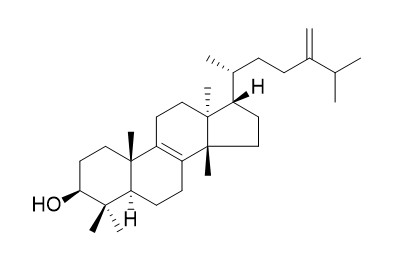Euphorbol
Euphorbadienol is a triterpenic compound isolated from the latex of Euphorbia resinifera. The derivatives of Euphorbadienol can be used as elicitors of disease resistance, and has antileishmanial and antitrypanosomal activity.
Inquire / Order:
manager@chemfaces.com
Technical Inquiries:
service@chemfaces.com
Tel:
+86-27-84237783
Fax:
+86-27-84254680
Address:
1 Building, No. 83, CheCheng Rd., Wuhan Economic and Technological Development Zone, Wuhan, Hubei 430056, PRC
Providing storage is as stated on the product vial and the vial is kept tightly sealed, the product can be stored for up to
24 months(2-8C).
Wherever possible, you should prepare and use solutions on the same day. However, if you need to make up stock solutions in advance, we recommend that you store the solution as aliquots in tightly sealed vials at -20C. Generally, these will be useable for up to two weeks. Before use, and prior to opening the vial we recommend that you allow your product to equilibrate to room temperature for at least 1 hour.
Need more advice on solubility, usage and handling? Please email to: service@chemfaces.com
The packaging of the product may have turned upside down during transportation, resulting in the natural compounds adhering to the neck or cap of the vial. take the vial out of its packaging and gently shake to let the compounds fall to the bottom of the vial. for liquid products, centrifuge at 200-500 RPM to gather the liquid at the bottom of the vial. try to avoid loss or contamination during handling.
Eur J Pharmacol.2023, 960:176121.
Evid Based Complement Alternat Med.2021, 8707280.
Research Square2021, 10.21203.
Food Science and Biotechnology2015, 2205-2212
ACS Omega2020, 5,33,20825-20830
Appl Microbiol Biotechnol.2024, 108(1):207.
Adv. Anim. Vet. Sci.2024, 12(4):732-741
Antioxidants (Basel).2021, 10(11): 1802.
Journal of Molecular Liquids2022, 364:120062.
Environ Toxicol.2020, doi: 10.1002
Related and Featured Products
Z Naturforsch C J Biosci . Jul-Aug 2011;66(7-8):360-366.
Antileishmanial and antitrypanosomal activity of triterpene derivatives from latex of two Euphorbia species[Pubmed:
21950160]
The in vitro activity on Leishmania infantum promastigotes and Trypanosoma cruzi epimastigotes of 25 semisynthetic terpenoid derivatives has been evaluated. These compounds were obtained through chemical modifications of the major components of Euphorbia resinifera (alpha-euphol and alpha-Euphorbol) and Euphorbia officinarum (obtusifoliol and 31-norlanosterol). Leishmaniasis and Chagas' disease are major worldwide health problems. The drugs of choice for their treatment are still problematic in both cases, and therefore there is an urgent need to discover new drugs with high activity and low side effects. Natural products have become a key source of new drugs in the last years. The genus Euphorbia has been the subject of abundant phytochemical and pharmacological research because of its potential medical applications, but the antiparasitic effects of derivatives from plants of this genus are still unknown. Our results showed that 76% and 64% of the test compounds had antiparasitic effects on L. infantum and T cruzi, respectively. The different activities on both parasites, especially their moderate effects on mammalian cells, indicate an interesting selective toxicity.
Phytochemistry . 2017 Mar;135:169-180.
Triterpene derivatives from Euphorbia enhance resistance against Verticillium wilt of tomato[Pubmed:
28027775]
Oxidation of α-Euphorbol and 31-norlanostenol, two triterpenic compounds isolated from the latex of Euphorbia resinifera and Euphorbia officinarum respectively, yielded four products named 3β-tosyloxy-4α,14α-dimethyl-5α-cholesta-7,9-diene; 4α,14α-dimethyl-5α-cholesta-7,9-dien-3β-ol; 24-methylen-elemo-lanosta-8,24-dien-3-one and elemo-lanost-8-en-3,11,24-trione. They were evaluated for protection of tomato plants against Verticillium dahliae in a greenhouse. The four semisynthesized products were phytotoxic at higher concentrations as they completely inhibited tomato germination at 100 and 500 μg/ml. However at lower concentrations (10 and 50 μg/ml) germination and root length were not affected. Disease resistance against Verticillium wilt was assessed in tomato plants derived from seeds that germinated in the presence of 10 and 50 μg/ml of the four products. All of them were able to reduce significantly disease severity, with 10 μg/ml being more effective than 50 μg/ml. Reduction of leaf alteration index and of stunting index ranged from 52 to 68% and from 43 to 67%, respectively, while vessel discoloration was reduced by at least 95%. The compounds were also able to elicit H2O2 accumulation before and after fungal inoculation and to significantly enhance peroxidase and polyphenol oxidase activities. These results suggest that the hemisynthetized triterpenes can be used as elicitors of disease resistance.
Phytochemistry . 2008 Apr;69(6):1328-38.
Bioactive triterpene derivatives from latex of two Euphorbia species[Pubmed:
18304594]
We have investigated the antifeedant and toxic effects of 23 semisynthetic terpenoid derivatives obtained through chemical modifications of the major components of Euphorbia resinifera (alpha-euphol and alpha-Euphorbol) and E. officinarum (obtusifoliol and 31-norlanostenol) latex on several insect species (Spodoptera littoralis, Myzus persicae and Rhopalosiphum padi), their selective cytotoxicity on insect Sf9 and mammalian CHO cells and their phytotoxic effects on Lactuca sativa. The conversions focused mainly on positions 3,7,11, and 24 with several oxidizing agents. A total of 18 compounds affected S. littoralis growth (IGR). Our results support the importance of the C-3 substituent, suggest the involvement of the C-7 substituent and indicate that the C-3 hydroxyl is not essential for the IGR effect. Overall, Sf9 cells were more sensitive to the active compounds than CHO cells. All of these compounds had non selective moderate phytotoxic effects on radicle elongation of L. sativa.



